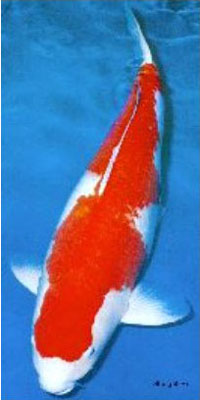
Straight Hi Kohaku

Nidan Kohaku
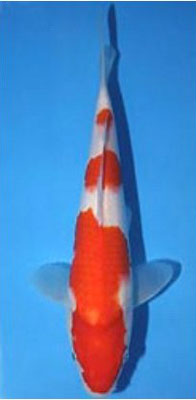
Sandan Kohaku
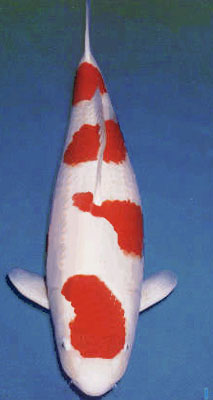
Yondan Kohaku
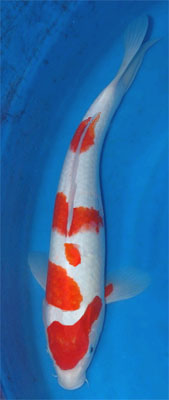
Godan Kohaku
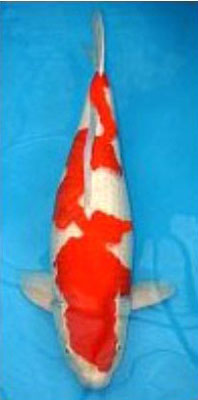
Inazuma Kohaku
Kohaku is one of the most beautiful koi with its pure white body and intense-red patterns. The white cannot have a yellow tint, it must be snow-white, and the Hi (red) must be consistent, evenly colored, without thin, discolored spots. Red is not desirable on the fins.
The edge of the red pattern must be sharp and clear against the white background (this edge is called "kiwa").
The red pattern should be artistically well-balanced.
One of the most important factors to be considered is the body conformation. Don’t choose a Kohaku simply because it has a beautiful pattern. Poor body conformation is usually a result of more serious internal problems that will eventually result in health problems.
 Straight Hi Kohaku |
 Nidan Kohaku |
 Sandan Kohaku |
 Yondan Kohaku |
 Godan Kohaku |
 Inazuma Kohaku |
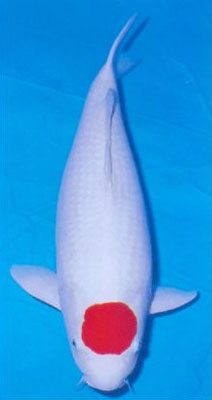 Tancho Kohaku |
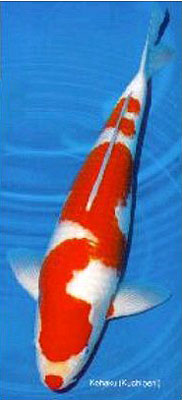 Kuchibeni Kohaku |
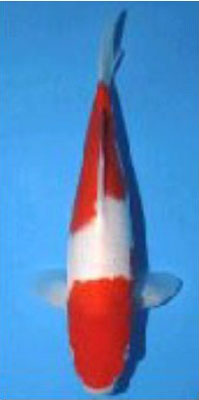 Menkaburi Kohaku |
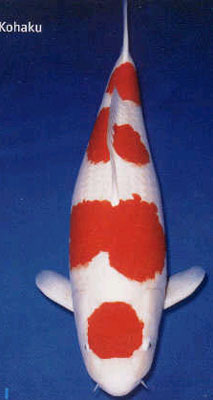 Maruten Kohaku |
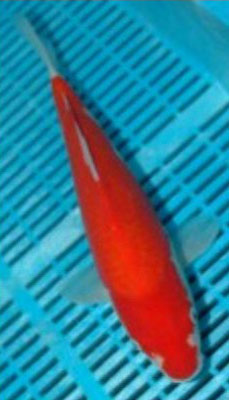 Omoyo Kohaku |
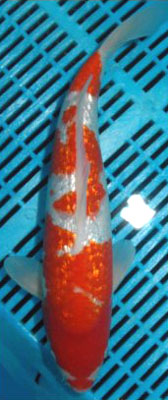 Ginrin Kohaku |
Kohaku come in hundreds of patterns. Some of the more recognized ones are:
- by patterns on the body:
Omoyo: one step pattern. A continuous, large, unbroken pattern from head to tail.
Straight Hi: Single, continuous Hi pattern, but the red patches are interconnected.
Nidan: two step pattern. Two islands of red color that are not interconnected.
Sandan: three step pattern. (Yondan - four step, Godan - five step, etc.)
Inazuma: pattern resembling a lightning strike; zig-zag pattern.
- by markings on the head:
Tancho: Pure white body with a single roundish red marking on the head between the eyes
(with no other red on the body).
Kuchibeni: red lipstick-like markings, red (beni) on the mouth.
Menkaburi: “hood” pattern - going behind, below the eyes often to the mouth.
Maruten: "crown" on the head pattern - a red mark on the head (similar to Tancho) but with red patterns
on the rest of the body too.
Kohaku are sensitive to water conditions. In hard water they will develop small black freckles (called "shimi") on the skin. Softer water will prevent shimi from forming and will also contribute to the development of the red (beni).
In very young koi the red starts out as a pale yellow and, in time, it changes to orange and later to red.
Males tend to develop the red faster than females, but their color also tends to diminish faster. Females might take longer to develop the red but their colors will last longer, this aspect making them more desirable among the hobbyists.
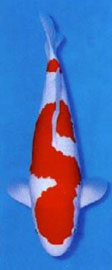 There are fundamental points to look for in a kohaku. Pattern for the head, body, the tail, and the fins. A red marking is indispensable for the head, even if it has beautiful patterns on the body, a koi without a head Hi will be amoung the first culled.
There are fundamental points to look for in a kohaku. Pattern for the head, body, the tail, and the fins. A red marking is indispensable for the head, even if it has beautiful patterns on the body, a koi without a head Hi will be amoung the first culled.
The ideal shape of the head Hi is a large U spreading over the head, a head Hi which spreads all over the head is not preferable.
The mouth region should be white, the Hi which spreads down to the lips, and not covering the cheeks and jaws is also disliked.
The ideal end line of the head Hi is the nose line, and at least down to the eyes. A head Hi that is neither too large nor too small is preferable. The head Hi should not spread down to the mouth tip, if it is split in some place, no mouth Hi is acceptable. The head Hi must not cover the eyes, jaws, and cheeks, but must be as large as possible.
The back should have a pattern well-balanced on both sides. A large mark on the shoulders near the head makes a Kohaku look imposing. A V shaped white cut on the shoulders is desirable. A continuous pattern from the head to shoulders without any cuts looks dull.
The distance between the last Hi and the tail joint should be about 2cm. As the fish grows larger, this distance increases, the last Hi spreading over the tail is disliked, no fins should have Hi.
The skin should be snow white, the Hi deep, each pattern is different but should show a clean cut edge.The Kohaku should look imposing, elegant and the pattern well balanced.
The basic factors of Kohaku are, Bright Hi, Sharp pattern edges, no Hi over the eyes and fins, no Hi markings spreading below the lateral line, head Hi that does not spread below the nose, and tail Hi that does not spread over the caudal fin.
(http://australiankoiassoc.bizland.com/Appreciationofkoi.chtml)
Kohaku Koi are the most popular Koi in Japan. Kohaku, Sanke and Showa Koi are called the "Gosanke" which means "The Three Families." In the United States, "Gosanke" Koi are often referred to as "The Big Three."
Kohaku are white bodied koi with red markings (sometimes more orange than red)... Ideally the white of the body is like fine porcelain in color, with the red well-demarcated (not "bleeding"). Red is undesirable on the fins, and unless specified in a particular sub-variety, not below the eyes or on the mouth.
Several "sub-varieties", designator terms are utilized with Kohaku type koi:
By Hi: "He", Red Patterns on the Body:
Straight Hi: Pattern like meandering islands of red that are interconnected.
Inazuma: Interconnected red pattern looking "Like a Lightning Bolt".
Nidan (Ni is two in Japanese): Two Step pattern. Two islands of red color that are not interconnected.
Sandan (San is three in Japanese): Three Step pattern. Three islands of red color that are not interconnected.
Yondan (Yon is four in Japanese): Four Step pattern. Four islands of red color that are not interconnected.
By Red Markings on the Head:
Kuchibeni: "Lipstick"; with red on the oral lobes.
Menkaburi: With "A Hood on the head". Going behind, below the eyes often to the mouth.
Maruten: With a "Crown on the head". A reddish mark, though with more red on the body.
Tancho: With a "Red Sun" marking on head, and lacking other red on the body. Best if the "spot" is bright red, w/o bleeding color, and circular, centered on the head.
(http://www.wetwebmedia.com/pondsubwebindex/koivarieties.htm)
Koh-haku koi are the cornerstone of any serious koi collection. They are fairly simple in appearance, with red markings on a white body. But simplicity aside, this is undeniably the most important and most fundamental koi variety. Koh-haku form the root breeding stock of many other varieties, and they commonly win the "grand champion" award at prestigious koi shows.
(http://www.rothteien.com/archives/koi/varieties.htm)
KOHAKU
It is said “appreciation of koi starts and ends with Kohaku”. What that means is Kohaku was the first class to be bred consistently or stabilized in about 1890. It also means that after a person has studied all of the classes of koi and has become experienced, they will come back to appreciate Kohaku for its simplicity and beauty. I will keep the amount of Japanese terminology to a minimum in this lecture. A Japanese term dictionary will be available soon in KOIUSA magazine and on the AKCA website.
Before I continue on Kohaku, I want to take a minute to discuss judging points common to all classes.
Koi are judged as a whole or holistically and are not judged on a positive or negative point system. Negative points can come into play in close contests.
Koi are judged side by side based on what we see today and not what may be there next week or next year. Japanese Judges have a disadvantage in often being able to recognize bloodlines, which can cloud their “judge for today” decisions because they know which koi cost more and has more potential. A Japanese Judge once answered a question on why a koi won an award replying, “because it was the most expensive fish”. Koi may lose today only to come back to win tomorrow based on the competition tomorrow.
Now for Kohaku.
We have a snow white (shiro) base color with a red (hi) pattern. The pattern may be stepped or continuous. The white must be without blemish or yellow tint. The hi may be any one of the many hues from deep persimmon orange to Ferrari red but the red must be thick without any thin spots and the pattern must be the same color from head to tail. Some Judges prefer the persimmon orange hi to the Ferrari red because the orange appears soft and the purple red appears hard and gaudy.
Kohaku must have red pattern on the head.
The pattern on the body must be artistically balanced and the kiwa or rear edges of each spot must be sharp like cut with a razor.
A new bias in Japan has started to favor bloodlines that have the kiwa stop at the edge of each scale forming a scalloped edge rather than a straight edge across the center of a scale. The front edge of each spot (not on the head) may have blurred red color that is called “sashi” or insertion. Sashi indicates the koi is still improving in quality and is not finished yet. It is elegant if a Kohaku has a white nose and a white area with no red pattern just in front of the tail called a “tail stop” and several other names.
Some subtleties of pattern not liked are a totally red head or red down the face to the nose that are heavy in appearance. Red pattern wrapping below the lateral line suggests a future koi when the red and white are better balanced. Red spots below the lateral line are disliked. The lateral line is a raised sensory organ running the full length of a koi half way up the side of a koi. A red head pattern with an additional red lip mark is called “kuchibeni” and can be cute if it balances the overall pattern. Red pattern at the base of the pectoral fin was considered unfavorable but is being accepted now if it adds to the overall balance of the pattern. Red into the tail or into the dorsal fin is still disliked.
Kohaku tend to get black specks “shimis” in hard water with high pH.
(http://www.akca.org/library/koiclass.htm)